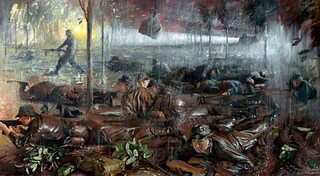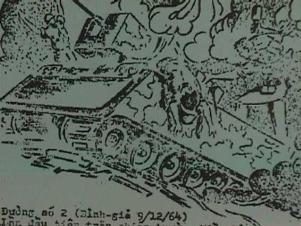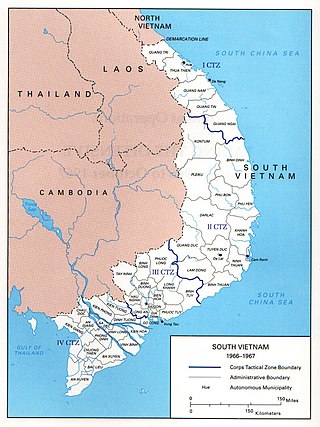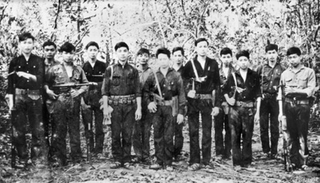
The Battle of Long Tan took place in a rubber plantation near Long Tân, in Phước Tuy Province, South Vietnam, during the Vietnam War. The action was fought between Viet Cong (VC) and People's Army of Vietnam (PAVN) units and elements of the 1st Australian Task Force.
Long Tân is a commune (xã) and village in Đất Đỏ District, Bà Rịa–Vũng Tàu province, Vietnam, at 10°31′N107°16′E. When it was part of South Vietnam, it was in Phước Tuy province.

The 1st Australian Task Force was a brigade-sized formation which commanded Australian and New Zealand Army units deployed to South Vietnam between 1966 and 1972. 1 ATF was based in a rubber plantation at Nui Dat, 8 kilometres (5.0 mi) north of Bà Rịa in Phuoc Tuy Province and consisted of two and later three infantry battalions, with armour, aviation, engineers and artillery support. While the task force was primarily responsible for securing Phuoc Tuy Province, its units, and the Task Force Headquarters itself, occasionally deployed outside its Tactical Area of Responsibility.

The Battle of Coral–Balmoral was a series of actions fought during the Vietnam War between the 1st Australian Task Force and the North Vietnamese People's Army of Vietnam (PAVN) 7th Division and Viet Cong (VC) Main Force units, 40 kilometres (25 mi) north-east of Saigon. Following the defeat of the PAVN/VC Tet offensive in January and February, in late April two Australian infantry battalions—the 1st and 3rd Battalions of the Royal Australian Regiment (RAR)—with supporting arms, were again deployed from their base at Nui Dat in Phước Tuy Province to positions astride infiltration routes leading to Saigon to interdict renewed movement against the capital. Part of the wider allied Operation Toan Thang I, it was launched in response to intelligence reports of another impending PAVN/VC offensive, yet the Australians experienced little fighting during this period. Meanwhile, the PAVN/VC successfully penetrated the capital on 5 May, plunging Saigon into chaos during the May Offensive in an attempt to influence the upcoming Paris peace talks scheduled to begin on the 13th. During three days of intense fighting the attacks were repelled by US and South Vietnamese forces, and although another attack was launched by the PAVN/VC several days later, the offensive was again defeated with significant losses on both sides, causing extensive damage to Saigon and many civilian casualties. By 12 May the fighting was over, and the PAVN/VC were forced to withdraw having suffered heavy casualties. US casualties were also heavy and it proved to be their most costly week of the war.

The Battle of Bình Giã was conducted by the Viet Cong (VC) and People's Army of Vietnam (PAVN) from December 28, 1964, to January 1, 1965, during the Vietnam War in Bình Giã, Phước Tuy province, South Vietnam.

The Battle of Phước Long was a decisive battle of the Vietnam War which began on December 12, 1974, and concluded on January 6, 1975. The battle involved the deployment of the People's Army of Vietnam (PAVN) 4th Army Corps for the first time, against determined units of the Army of the Republic of Vietnam (ARVN) in Phước Long in Bình Phước Province near the Cambodian border, under the command of Lieutenant General Dư Quốc Đống.

The Battle of Binh Ba, also known as Operation Hammer, was a battle during the Vietnam War. The action occurred when Australian Army troops from the 5th Battalion, Royal Australian Regiment fought a combined force of People's Army of Vietnam (PAVN) and Viet Cong (VC), including a company from the PAVN 33rd Regiment and elements of the VC D440 Battalion, in the village of Bình Ba, 5 kilometres (3.1 mi) north of Nui Dat in Phuoc Tuy Province. The battle was unusual in Australian combat experience in South Vietnam as it involved fierce close-quarter house-to-house fighting, although the majority of enemy killed was through heavy artillery and air-bombardment. In response to PAVN/VC attempts to capture Binh Ba the Australians assaulted the village with infantry, armour and helicopter gunships, routing the VC and largely destroying the village itself. Such battles were not the norm in Phuoc Tuy, however, and the heavy losses suffered by the PAVN/VC forced them to temporarily leave the province. Although the Australians did encounter PAVN/VC Main Force units in the years to come, the battle marked the end of such large-scale clashes, and ranks as one of the major Australian victories of the war.

The Battle of Xa Cam My was fought over two days from April 11–12, 1966, 10 miles (16 km) south of the village of Cam My in Phuoc Tuy Province, during the Vietnam War. Originally planned as a U.S. search and destroy mission intended to lure out the "crack" Viet Cong (VC) D800 Battalion, Charlie Company, 2nd Battalion, 16th Infantry Regiment soon found itself fighting for survival in the rubber plantations of Cam My village, approximately 42 miles (68 km) east of Saigon. During this battle 134 men of Charlie Company, 2/16th Infantry were ambushed by the VC and 80 percent became casualties.

Operation Bribie, also known as the Battle of Ap My An, was fought during the Vietnam War in Phuoc Tuy province between Australian forces from the 6th Battalion, Royal Australian Regiment and two companies of Viet Cong from D445 Battalion, likely reinforced by North Vietnamese regulars. During the night of 16 February the Viet Cong attacked a South Vietnamese Regional Force compound at Lang Phuoc Hai, before withdrawing the following morning after heavy fighting with South Vietnamese forces. Two hours later, a Viet Cong company was reported to have formed a tight perimeter in the rainforest 2 kilometres (1.2 mi) north of Lang Phuoc Hai, near the abandoned hamlet of Ap My An. In response, the Australians deployed a quick reaction force. Anticipating that the Viet Cong would attempt to withdraw, as they had during previous encounters, forces from the 1st Australian Task Force were inserted to block the likely withdrawal route in the hope of intercepting and destroying them.

The Seventh Division was part of the Army of the Republic of Vietnam (ARVN), the army of the nation state of South Vietnam that existed from 1955 to 1975. It was part of the IV Corps, which oversaw the Mekong Delta region of the country.

Operation Coburg was an Australian and New Zealand military action during the Vietnam War. The operation saw heavy fighting between the 1st Australian Task Force and North Vietnamese People's Army of Vietnam (PAVN) and Viet Cong (VC) forces during the wider fighting around Long Binh and Bien Hoa.

At the beginning of 1966, the number of U.S. military personnel in South Vietnam totaled 184,300. South Vietnamese military forces totaled 514,000 including the army (ARVN) and the Regional Force and Popular Force militias. The North Vietnamese People's Army of Vietnam (PAVN) numbered 400,000, most still in North Vietnam. 50,000 PAVN cadre and soldiers infiltrated South Vietnam during 1965. Group 559, charged with transporting supplies down the Ho Chi Minh Trail to supply PAVN troops in both South Vietnam and Laos, numbered 24,400 personnel. The U.S. estimated the number of Viet Cong (VC) and PAVN soldiers in South Vietnam at nearly 280,000 by June 1966, including part-time guerrillas. A pause in the bombing of North Vietnam by U.S. warplanes had been announced by President Johnson on 24 December and remained in effect.

The Battle of Suối Châu Pha was fought during the Vietnam War between Australian troops and the Việt Cộng. The battle took place during Operation Ballarat, an Australian search and destroy operation in the eastern Hát Dịch area, north-west of Núi Đất in Phước Tuy province. Following a covert insertion the day before which had caught a number of Việt Cộng sentries by surprise, A Company, 7th Battalion, Royal Australian Regiment had patrolled forward unaware of the presence of a large Việt Cộng main force unit nearby. Clashing with a reinforced company from the Việt Cộng 3rd Battalion, 274th Regiment, a classic encounter battle ensued between two forces of roughly equal size. Fought at close quarters in dense jungle amid a heavy monsoon rain, both sides suffered heavy casualties as neither was able to gain an advantage. Finally, after a battle lasting several hours, the Australian artillery proved decisive and the Việt Cộng were forced to withdraw, dragging many of their dead from the battlefield after having suffered crippling losses.

The 445th Battalion, also known as the D445 Provincial Mobile Battalion or the Ba Ria Battalion, was a local force battalion of the Viet Cong (VC) during the Vietnam War.
The VC 5th Infantry Division was a division of the Viet Cong during the Vietnam War and later became part of the People's Army of Vietnam.
The VC D440 Battalion, also known as the Viet Cong D440 Provincial Mobile Battalion, was a Local Force battalion of the Viet Cong (VC) during the Vietnam War. The battalion operated in the Phước Tuy and Long Khánh provinces usually along Route 2. It was formed in 1968 under the command of Comrade Hai Tinh and consisted mainly of North Vietnamese Army (NVA) personnel.
The Battle of Núi Lé was the last major battle fought by Australian and New Zealand forces in South Vietnam. The battle was fought in the former Phước Tuy Province between elements of the People's Army of Vietnam (PAVN) 33rd Regiment and 'B' and 'D' Companies of the 4RAR/NZ (ANZAC) Battalion and during Operation Ivanhoe. Núi Lé, a small hill within Quang Thanh commune in Chau Duc District, is today in Ba Ria-Vung Tau Province.
This is an order of battle listing the Australian and Viet Cong forces involved in the Battle of Long Tan which occurred in Phuoc Tuy Province, South Vietnam on 18 August 1966.

The Battle of Long Tan took place on 18 August 1966 in Phuoc Tuy Province, South Vietnam during the Vietnam War between Viet Cong and North Vietnamese units from the Viet Cong 275th Regiment, possibly reinforced by at least one North Vietnamese battalion, and D445 Provincial Mobile Battalion, and Australian forces from D Company, 6th Battalion, Royal Australian Regiment. Although the Australians were heavily outnumbered and almost overwhelmed by the Viet Cong the battle ended in a decisive victory for them, establishing their dominance over the province. This perspective however sharply contrasts with competing interpretations in which the D445 Battalion had garnered strong political support in Phuoc Tay. Furthermore, the local D445 Battalion was redeployed northwards against the newly deployed 11th Armored Cavalry Taskforce a month later and so the true significance of the battle is called into question.

Operation Hardihood was a security operation conducted from 16 May to 8 June 1966 during the Vietnam War by the U.S. 503rd Infantry Regiment, the 1st Battalion, Royal Australian Regiment (1RAR) and the 5th Battalion, Royal Australian Regiment in Phước Tuy Province, South Vietnam to secure the area around Nui Dat for the establishment of a base area for the 1st Australian Task Force.














